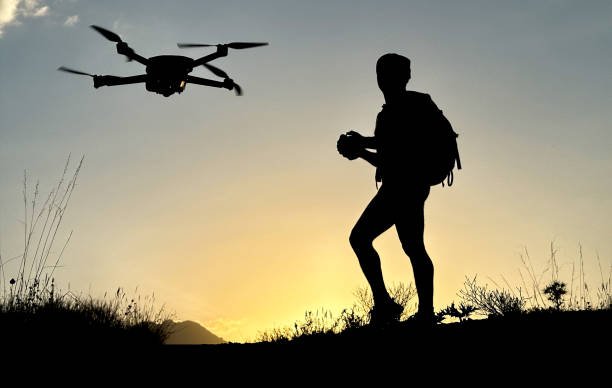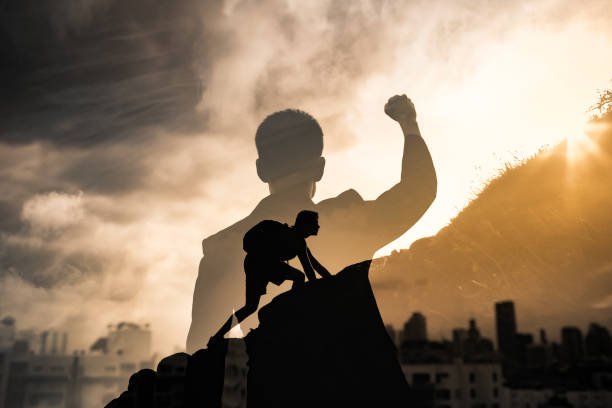Picture this: You’ve just summited a grueling mountain trail. The world unfolds below you in a breathtaking panorama of jagged peaks and sun-drenched valleys. Your phone camera can’t do it justice. Your DSLR is back at camp because you couldn’t justify the weight. This is the moment you crave—the shot that defines the entire trip. But how do you capture it?
The answer is no longer a bulky, complicated piece of kit. It’s a technological marvel that fits in your jacket pocket. Welcome to the golden age of compact drones, the ultimate tool for the modern adventurer. These lightweight powerhouses have fundamentally changed the game, allowing you to capture cinematic, jaw-dropping perspectives that were once reserved for Hollywood film crews.
Forget the days of sacrificing image quality for portability. Today’s best compact drones are packed with professional-grade cameras, astonishingly smart flight features, and the ruggedness to handle the wild. Whether you’re a solo backpacker, a weekend warrior, or a globetrotting explorer, there’s a drone on this list that will elevate your adventure photography from simple snapshots to epic storytelling.
Table of Contents
What to Look For in an Adventure Drone: The Modern Explorer’s Checklist
Before we dive into the top models of 2025, let’s establish our mission parameters. Not all drones are created equal, especially when your shooting location is a remote cliffside instead of a manicured park. Here’s the essential gear-check for any adventure-ready drone.
Portability & Weight (The Sub-250g Magic)
This is non-negotiable. For adventure photography, every ounce matters. A heavy drone is a drone that gets left behind. The sweet spot is the sub-250 gram (or ~8.8 ounce) category. In the United States and many other countries, drones under this weight don’t require registration with the FAA for recreational use. This means less red tape and more freedom to fly. More importantly, it means the drone is small enough to disappear into a side pocket of your backpack, ready to deploy at a moment’s notice.
Jaw-Dropping Image Quality
We’re not just looking for a bird’s-eye view; we’re looking for a beautiful bird’s-eye view. Don’t get blinded by megapixel counts. The most critical factor is the camera sensor size. A larger sensor captures more light, resulting in better detail, superior low-light performance, and richer colors. Also, look for the ability to shoot in RAW format. RAW files contain unprocessed data from the sensor, giving you maximum flexibility to edit your photos in software like Adobe Lightroom without losing quality. For video, 4K is the standard, but look for high bitrates and color profiles like D-Log for professional-grade color grading.
Durability & Wind Resistance
The wild is unpredictable. A calm morning can turn into a windy afternoon in minutes. Your adventure drone needs to be able to hold its own. While compact drones will never be as stable as their larger, heavier counterparts, modern models have incredible stabilization technology. Check the manufacturer’s stated wind resistance levels (often given in mph or on the Beaufort scale). A robust build quality ensures it can handle the occasional bump and scrape of being packed and unpacked in rugged environments.
Battery Life & Flight Time
There’s nothing more frustrating than your drone’s battery dying just as the perfect golden-hour light hits the landscape. Look for a realistic flight time of around 30 minutes per battery. Most serious adventurers carry multiple batteries. The “Fly More Combo” offered by many manufacturers is almost always worth the investment, typically including two extra batteries and a multi-charger, ensuring you have enough power for a full day of shooting.
Intelligent Flight Modes: Your Co-Pilot in the Wild
When you’re on a solo adventure, you are the talent, the director, and the pilot. This is where intelligent flight modes become your best friend.
- ActiveTrack (or Follow Me): This is the game-changer. The drone can lock onto you and follow you automatically as you hike, bike, or kayak, keeping you perfectly in frame. It’s like having a personal aerial film crew.
- QuickShots/MasterShots: These are pre-programmed cinematic flight paths. With a single tap, the drone can perform complex maneuvers like orbiting a point of interest or executing a dramatic reveal shot, giving your videos an instant professional polish.
- Obstacle Avoidance: Crucial for peace of mind. Sensors on the front, back, bottom, and even sides of the drone detect obstacles like trees and rocks, preventing costly crashes. For complex environments like forests or canyons, this feature is a lifesaver.
The 5 Best Compact Drones for Adventure Photographers in 2025
We’ve scoured the market, tested the tech, and packed our virtual bags. These are the top 5 compact drones that strike the perfect balance between power, portability, and adventure-readiness for 2025.
1. DJI Mini 4 Pro: The Unbeatable All-Rounder
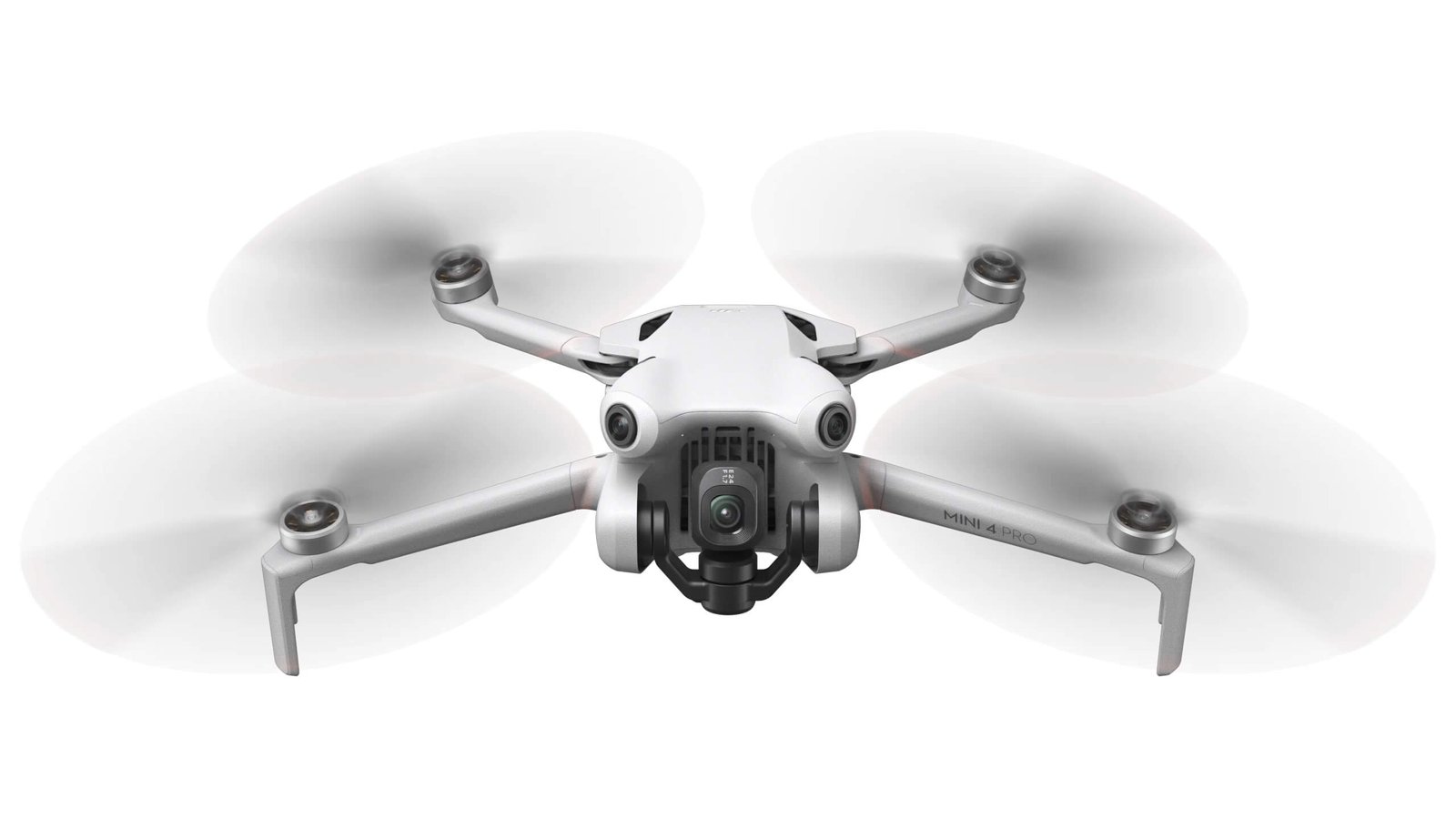
Best For: The adventurer who wants pro-level features in the smallest possible package.
If you could only choose one drone for every possible adventure, the DJI Mini 4 Pro would be it. It’s the undisputed champion of the sub-250g class, packing an insane amount of technology into a body that folds down to the size of a water bottle.
The Mini 4 Pro’s biggest upgrade is its omnidirectional obstacle sensing. For the first time in the Mini series, it has sensors covering 360 degrees, giving you the confidence to fly in complex environments like dense forests or narrow slot canyons without fear. It essentially has a protective bubble around it.
The camera is a masterpiece. Its 1/1.3-inch CMOS sensor delivers stunning 48MP RAW photos and buttery-smooth 4K/60fps HDR video. What truly sets it apart is its ability to shoot in D-Log M color profile, providing flat, detail-rich footage that is a dream for color grading. Plus, the camera can rotate 90 degrees to shoot true vertical video, perfect for sharing your adventures on social media without cropping.
| Key Specs | DJI Mini 4 Pro |
| Weight | < 249 g |
| Camera Sensor | 1/1.3-inch CMOS, 48MP |
| Max Video | 4K/60fps HDR, 10-bit D-Log M |
| Flight Time | 34 minutes |
| Obstacle Sensing | Omnidirectional (Forward/Backward/Upward/Downward/Sideways) |
| Standout Feature | True Vertical Shooting, ActiveTrack 360° |
Why it’s Incredible for Adventure: The Mini 4 Pro is the definition of “no compromises.” You get flagship-level obstacle avoidance and imaging in a go-anywhere, no-registration-needed package. The advanced ActiveTrack 360° allows you to draw a path for the drone to follow, giving you unparalleled creative control over your shots while you remain the center of the action. It’s the perfect, worry-free creative partner.
2. DJI Air 3: The Compact Workhorse with a Dual-Camera Punch
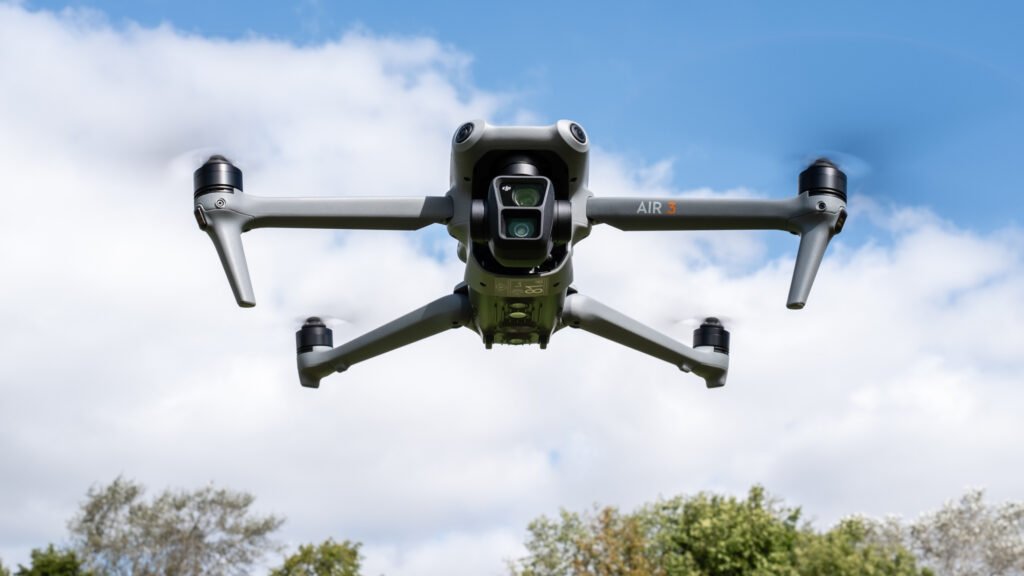
Best For: The serious photographer who wants more creative versatility and doesn’t mind a slightly larger pack size.
Stepping up slightly in size and capability, we have the DJI Air 3. While not a sub-250g drone (weighing in at 720g), it’s still remarkably compact and portable for the power it offers. Its secret weapon? A groundbreaking dual-camera system.
The Air 3 features two distinct cameras in one gimbal: a wide-angle and a 3x medium telephoto. This is a game-changer for adventure photography. You can capture the vast, sweeping landscape with the wide-angle lens, then, with a tap of a button, switch to the telephoto lens to compress the scene and make distant mountains look towering and majestic. It’s like having two prime lenses in the sky.
Both cameras share the same excellent 1/1.3-inch sensor as the Mini 4 Pro, so you never have to sacrifice quality for a different focal length. It also boasts omnidirectional obstacle sensing and an incredible 46-minute flight time, the longest in its class.
| Key Specs | DJI Air 3 |
| Weight | 720 g |
| Camera Sensor | Dual 1/1.3-inch CMOS (Wide & 3x Tele) |
| Max Video | 4K/100fps, 10-bit D-Log M |
| Flight Time | 46 minutes |
| Obstacle Sensing | Omnidirectional |
| Standout Feature | Dual-Camera System for creative framing |
Why it’s Incredible for Adventure: The Air 3 is for the visual storyteller. The ability to switch between wide and telephoto perspectives opens up a new dimension of creativity. Capture yourself small against a massive landscape with the wide lens, then punch in with the telephoto to show the texture of the rock face you’re about to climb. Its superior wind resistance and extended flight time make it a more reliable choice for high-altitude or coastal adventures where conditions can be demanding.
3. Autel EVO Nano+: The Mighty DJI Mini Competitor
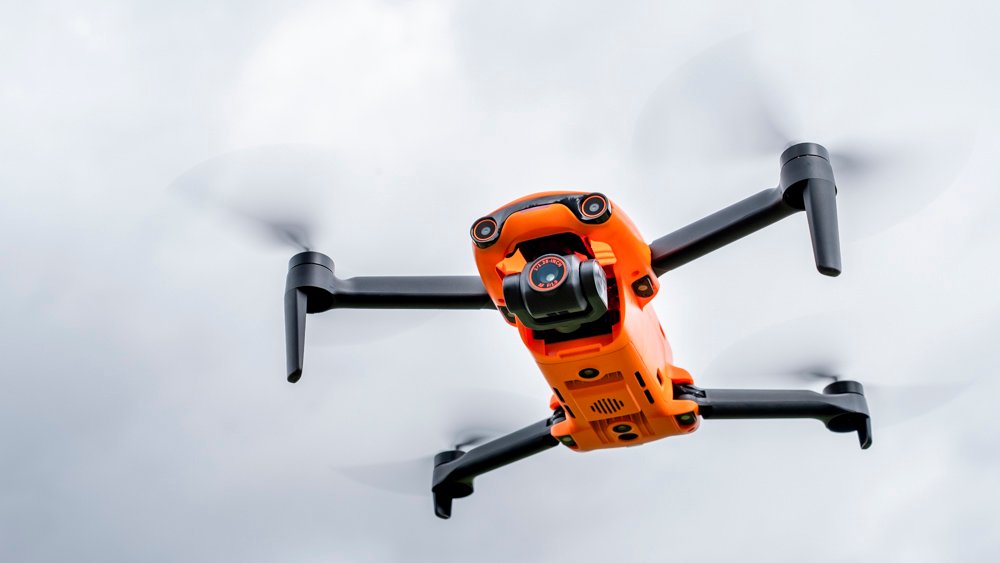
Best For: The adventurer who values low-light camera performance and wants a strong alternative to DJI.
Autel Robotics has consistently proven to be DJI’s most formidable competitor, and the EVO Nano+ is a testament to that. This sub-250g drone goes head-to-head with the DJI Mini series and shines brightly, particularly in the camera department.
The Nano+ features a large 1/1.28-inch CMOS sensor with an RYYB color filter array. In plain English, this means it’s an absolute beast in low-light conditions. It captures significantly more light than its direct competitors, resulting in cleaner, more vibrant photos and videos during the coveted golden hour and blue hour. If your adventures often extend into dusk, this is the drone for you.
It also boasts three-way obstacle avoidance (front, back, and bottom), which provides a solid safety net for most situations. Its Dynamic Track 2.1 offers reliable subject tracking, making it a great tool for capturing your movements on the trail.
| Key Specs | Autel EVO Nano+ |
| Weight | 249 g |
| Camera Sensor | 1/1.28-inch CMOS, 50MP, RYYB Filter |
| Max Video | 4K/30fps |
| Flight Time | 28 minutes |
| Obstacle Sensing | 3-Way (Forward/Backward/Downward) |
| Standout Feature | Exceptional low-light camera performance |
Why it’s Incredible for Adventure: The EVO Nano+ is for the light chaser. Its superior sensor performance at sunrise and sunset allows you to capture moody, atmospheric shots that other drones in its weight class might struggle with. It’s a fantastic, high-quality, and portable option that proves there’s more to the world of compact drones than just one brand.
4. Potensic ATOM: The Shockingly Capable Budget King
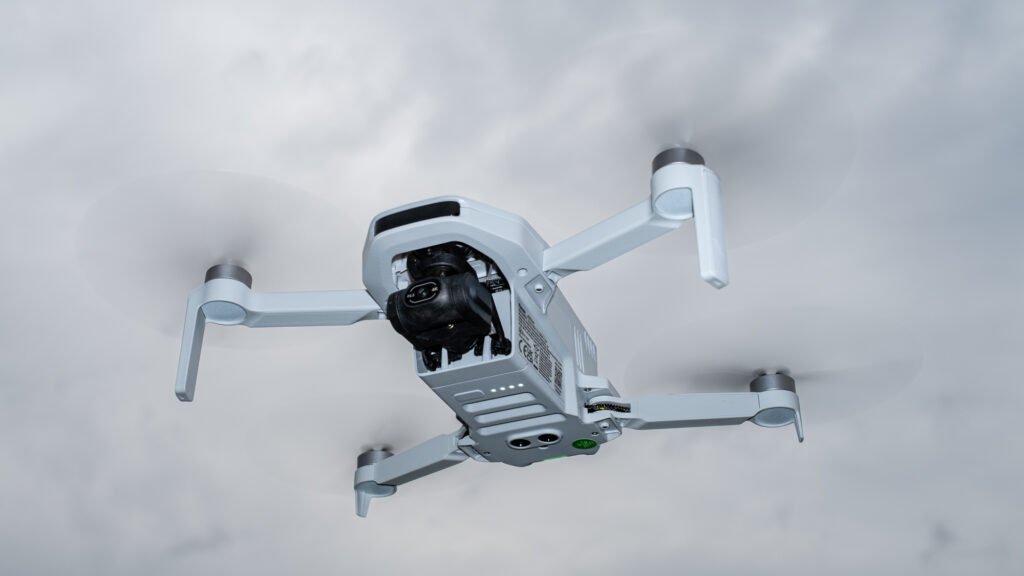
Best For: The adventurer on a budget who wants 4K video and GPS stability without breaking the bank.
Think you need to spend a fortune to get a great adventure drone? Think again. The Potensic ATOM is rewriting the rulebook for budget drones. For a fraction of the price of the big names, this sub-250g drone delivers features that were considered high-end just a couple of years ago.
The ATOM shoots surprisingly crisp 4K/30fps video and 12MP photos thanks to its Sony CMOS sensor. Most importantly, it’s not a toy. It has a 3-axis gimbal for smooth footage and a dual GPS system for rock-solid hovering and a reliable return-to-home function.
While it lacks obstacle avoidance, its intelligent flight modes are impressive for the price point. It includes a “Follow Me” mode and waypoint flight, allowing you to plan a flight path in advance. With a flight time of over 30 minutes, it doesn’t skimp on endurance either.
| Key Specs | Potensic ATOM |
| Weight | < 249 g |
| Camera Sensor | Sony CMOS Sensor |
| Max Video | 4K/30fps |
| Flight Time | 32 minutes |
| Obstacle Sensing | None |
| Standout Feature | Unbeatable value for GPS and 4K video |
Why it’s Incredible for Adventure: The ATOM is the perfect entry point. It’s for the hiker who wants to experiment with aerial photography without a massive financial commitment. It’s light, capable, and reliable enough to get fantastic shots that will blow your social media followers away. You have to fly with more caution due to the lack of sensors, but for open-space adventures in mountains or along coastlines, it’s an absolute steal.
5. HoverAir X1: The Ultimate “Throw-and-Go” Selfie Drone
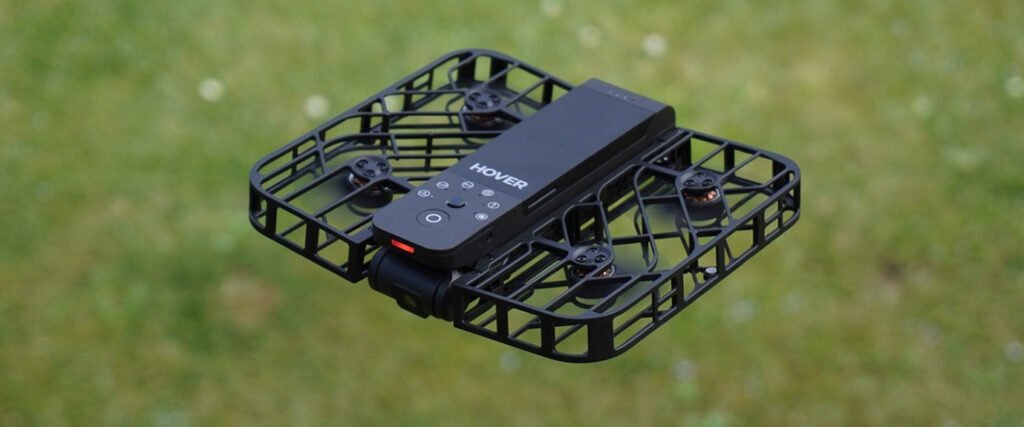
Best For: The solo adventurer, vlogger, or anyone who wants effortless, hands-free shots in seconds.
Our final pick is something a little different. The HoverAir X1 isn’t a traditional drone—it’s a self-flying camera. There’s no controller. You launch it from the palm of your hand. It’s designed for one thing: getting amazing, short clips of you and your friends with zero fuss.
Weighing a mere 125g, this thing is insanely portable. You select one of its pre-programmed flight paths (like Orbit, Follow, Reveal, etc.) with a button on the device, toss it lightly into the air, and it does the rest. It uses sophisticated visual tracking (VIO) to lock onto you and execute its flight path flawlessly before returning to land in your hand.
The enclosed propeller design makes it incredibly safe to use around people. While its video quality (up to 2.7K) and stabilization aren’t on par with a gimbal drone like the DJI Mini, they are more than good enough for incredible social media clips.
| Key Specs | HoverAir X1 |
| Weight | 125 g |
| Camera Sensor | N/A (focus on ease of use) |
| Max Video | 2.7K/30fps |
| Flight Time | ~10 minutes (shot-based) |
| Obstacle Sensing | None (but has VIO positioning) |
| Standout Feature | Unrivaled ease of use and portability |
Why it’s Incredible for Adventure: The HoverAir X1 is pure, unadulterated fun. It’s for the moments when you don’t want to stop your hike to fiddle with a controller and an app. Want a quick orbiting shot of you at a viewpoint? Just press a button and launch. It takes less than 30 seconds from pocket to shot. For the solo adventurer who wants to be in the adventure instead of just documenting it, the X1 is a revolutionary tool.
Frequently Asked Questions (FAQ) for Adventure Drone Pilots
You’ve got the mission briefing, but you still have questions. That’s what a good adventurer does—prepares for everything. Here are answers to the most common questions we get about flying compact drones in the wild.
1. Do I really need a license to fly these drones in the US?
It depends on the weight and your purpose. Here’s the simple breakdown:
- For Sub-250g Drones (like the DJI Mini 4 Pro, Autel Nano+, Potensic ATOM): If you are flying purely for fun and recreation, you are not required to register the drone with the FAA. However, you are still required to take and pass The Recreational UAS Safety Test (TRUST). It’s a free, easy, online test that covers basic safety rules.
- For Drones Over 250g (like the DJI Air 3): Yes. You must register this drone with the FAA (a simple online process with a small fee) and mark the registration number on the exterior of the drone. You also need to have your TRUST certificate with you when flying.
- Commercial Use: If you plan to sell your photos/videos or use them for any business purpose, you must obtain a Part 107 certificate from the FAA, regardless of the drone’s weight.
Always check local rules before you fly, as national parks, state parks, and wilderness areas often have their own specific restrictions.
2. How well do these drones handle bad weather like wind and rain?
This is a critical question for any adventurer. The short answer is: consumer drones are not waterproof. Do not fly them in rain, snow, or heavy fog. Water can fry the sensitive electronics instantly, leading to a crash and a very expensive paperweight.
As for wind, modern compact drones are surprisingly capable. Models like the DJI Air 3 can handle winds up to 27 mph. Lighter, sub-250g drones are more susceptible to being tossed around. While they can handle moderate breezes, it’s best to avoid flying in strong, gusty winds. It will drain your battery faster and can lead to unstable, shaky video. A good rule of thumb: if it feels too windy for you to be comfortable, it’s probably too windy for your drone.
3. What is the real-world flight range? Should I believe the numbers on the box?
Manufacturers often advertise very long ranges, sometimes up to 12 miles (20 km). It’s important to understand that this is the maximum range achieved in perfect, interference-free conditions with a direct line of sight.
In the real world, especially in mountains or areas with a lot of trees, your range will be significantly shorter. Most importantly, FAA regulations in the United States require you to always keep your drone within your Visual Line of Sight (VLOS). This means you should be able to see the drone with your own eyes at all times. For a small drone, this is realistically no more than a few thousand feet away. The powerful transmission systems aren’t for flying miles away, but for providing a strong, clear video feed to your controller even in challenging signal environments.
4. I’m a total beginner. Are these drones hard to fly?
You’ll be shocked at how easy modern GPS drones are to fly. Thanks to advanced stabilization, GPS positioning, and automatic takeoff/landing functions, they can hover perfectly in place with no input from you. If you get into trouble, you can often just let go of the sticks, and the drone will stop and wait for your next command.
However, there is still a learning curve. We highly recommend spending your first few flights in a large, open field away from people and obstacles. Practice basic maneuvers, get a feel for the controls, and experiment with the intelligent flight modes before you take it on a serious adventure. The confidence you build in a safe environment will be invaluable on a windy cliffside.
5. How do I charge my drone batteries when I’m backpacking or off-grid?
An excellent and practical question! Keeping your gear powered is a huge part of adventure planning. The “Fly More Combos” usually come with a charging hub that can charge three batteries sequentially. To power this hub in the wild, you have a few options:
- High-Capacity Power Bank: A quality power bank with a USB-C Power Delivery (PD) port is the most common solution. A 20,000mAh power bank can typically recharge two to three drone batteries, giving you plenty of flight time for a weekend trip.
- Portable Solar Panel: For longer, multi-day treks, pairing a power bank with a portable, foldable solar panel allows you to recharge your system during sunny days.
- Car Charger: If your adventure involves a vehicle, use an inverter or a dedicated USB-C car charger to juice up your batteries while driving between locations.
Your Adventure, Your Perspective
The right compact drone is more than just a camera; it’s a key to unlocking a new level of creativity and a new way of seeing the world you love to explore. From the professional-grade power of the DJI Mini 4 Pro and Air 3 to the budget-friendly brilliance of the Potensic ATOM, there has never been a better time to add an eye in the sky to your adventure gear.
Choosing the best one for you comes down to balancing your ambition with your budget and your adventure style. Do you need the absolute best image quality and safety features, or is ultimate portability and speed your top priority? Each drone on this list is a winner in its own right, ready to help you capture those once-in-a-lifetime moments from a perspective you’ve only dreamed of.
Now, it’s your turn. Which drone would you pack for your next epic journey? Are you team DJI, an Autel advocate, or is the simple genius of the HoverAir X1 calling your name?
Drop a comment below and let us know what your next destination is and which drone you’d take with you! And while you’re here, gear up for that journey by exploring the other essential guides and reviews on MindGearMen.

